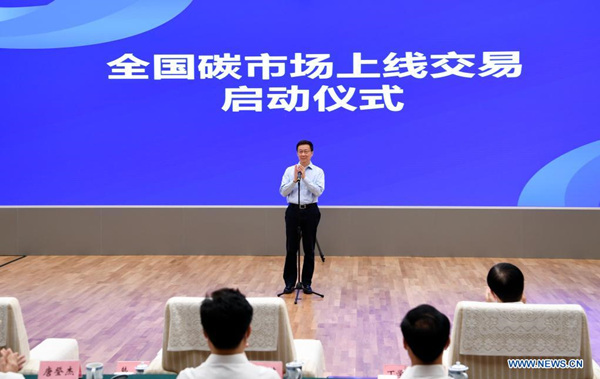World's largest carbon trading market opens in Shanghai
 0 Comment(s)
0 Comment(s) Print
Print E-mail Xinhua, July 17, 2021
E-mail Xinhua, July 17, 2021
China's national carbon market started trading on Friday, a significant step to help the country reduce its carbon footprint and meet emission targets, according to the Ministry of Ecology and Environment (MEE).

Chinese Vice Premier Han Zheng attended the launching ceremony in Beijing and announced the official start of the trading.
Trading began at 9:30 a.m. at the Shanghai Environment and Energy Exchange, with the opening price for carbon quotas at 48 yuan (7.4 U.S. dollars) per tonne. The first transaction was priced at 52.78 yuan per tonne, with a total value of 7.9 million yuan.
The first trading day concluded with total trading volume topping 4.1 million tonnes and a turnover of 210.23 million yuan. The transaction prices averaged 51.23 yuan per tonne.
Carbon emissions by more than 2,000 power companies involved in the first trading group are estimated to exceed 4 billion tonnes per year, making the market the world's largest in terms of the amount of greenhouse gas emissions covered.
The scheme initially involves companies in the power industry. Carbon emitters from other sectors such as steel, paper making and aviation will be added gradually.
Carbon trading is the process of buying and selling permits to emit carbon dioxide or other greenhouse gases.
Companies are assigned quotas for carbon emissions and can sell surplus emission allowances to those that expect to exceed their pollution quotas.
Commenting on the carbon market, Zhao Yingmin, vice minister of ecology and environment, said that it spurs high emitters to decarbonize industrial structure and energy consumption, and will help them become frontrunners in peaking carbon dioxide emissions.
The market also provides a price fillip for related companies to upgrade low-carbon technologies and embark on green transformation, Zhao said.
To maintain the healthy and stable development of the national carbon market, trading institutions have established a series of systems including price fluctuation limits, maximum position limits, large account reports, risk warnings and reserves, and abnormal trading monitoring.
It is necessary to further strengthen the top-level design, refine the roadmap, introduce more industries and trading entities into the market, and enrich trading varieties to help the carbon market play a better role in controlling greenhouse gas emissions, said Liu Jie, general manager of the Shanghai Environment and Energy Exchange.
China's national carbon trading market was launched in 2017 after pilot operations in seven provincial-level regions in 2011. Behind its launch was the aim of exploring market-based mechanisms to control greenhouse gas emissions.
The MEE will roll out trading regulations and improve relevant standards and management schemes while expanding the varieties and methods of trading.
As data authenticity and accuracy are the bases of trading, the MEE will work to ensure the quality and transparency of emission data.
Li Zhiqing, a researcher at Fudan University, said that there might not be abrupt price fluctuations in the emerging market. However, in light of the lower carbon trading volume and market prices compared with the international level, carbon prices are likely to rise in the mid- and long-term.
Industry analysts, meanwhile, called for efforts to prevent speculative behaviors and excessive financialization of the trading market. The fundamental objective of this scheme is to help reduce emissions.
The start of the trading in the national carbon market came as China's latest effort in realizing its goals of peaking carbon dioxide emissions by 2030 and achieving carbon neutrality by 2060.
Pursuing a green growth path, China has been working on all fronts to transform its coal-centered energy structure and build a clean and diversified energy supply system.
Official data shows the country ranks first globally in newly-installed wind-power capacity, and is also a global leader in the production and use of solar energy and hydropower.
By the end of 2020, more than 40 percent of China's installed power generation capacity came from renewable resources, supporting nearly one-third of the country's electricity consumption, according to data from the National Energy Administration.
As a result, 15.9 percent of China's primary energy consumption came from non-fossil energy, surpassing the target of 15 percent set for 2020.






Go to Forum >>0 Comment(s)